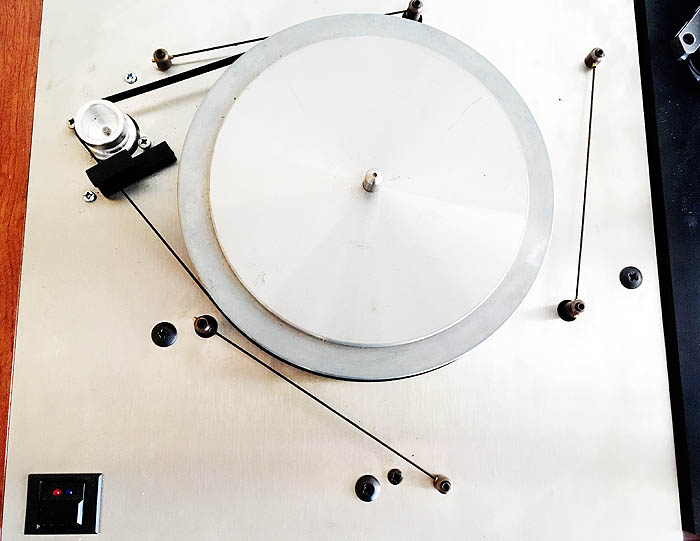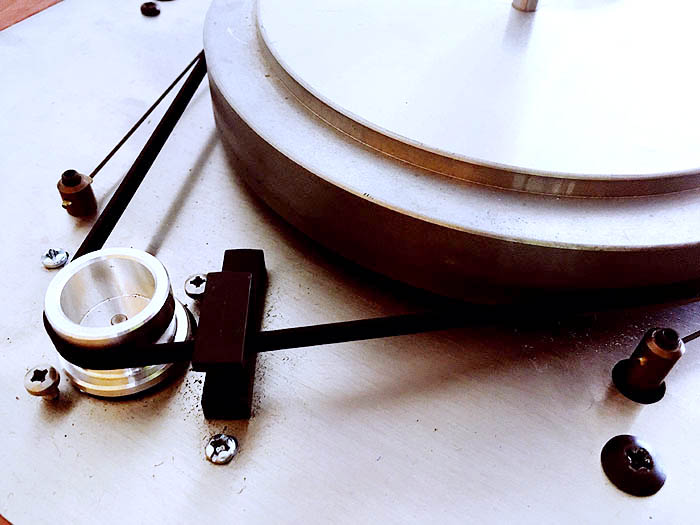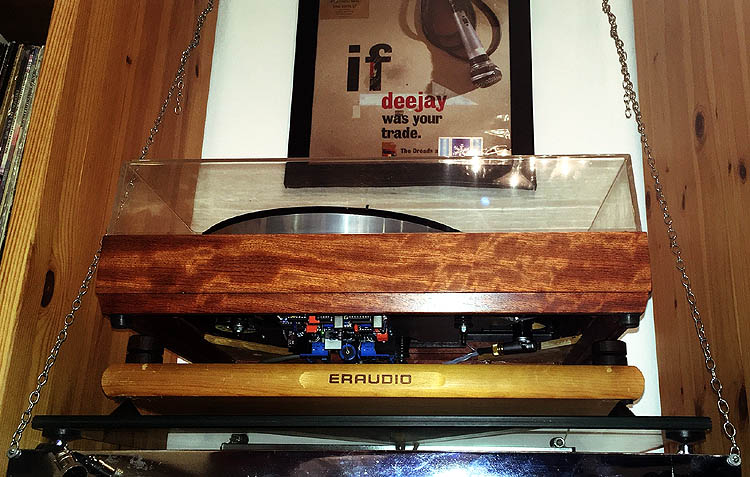
[Italian version here]
[ Home | Staff & Contacts | HiFi Playground | Listening tests | DIY & Tweakings | Music & Books ]
or
Product: Turntable Spoke Modification service
Manufacturer: Audiofiles, Crowthorne, Berkshire, UK
Price: £399 as reviewed but contact and ask; YMMV
depending on what you want from spoke only to full subchassis
Reviewer: Mark Wheeler - TNT UK
Reviewed: October, 2019
"Already in the titles the Old Scribe has begun scraping the barrel of puns," complain plebs, stage left, "Is this the standard of prose we have to endure today?
The concept of bouncing a turntable's working bits on coil spring suspension, much like a vehicle, is usually credited to Edgar Vilchur. In its 50th-anniversary issue in 2006, Hi-Fi Snooz ranked him No. 1 among the 50 Most Important Audio Pioneers. His basic 3 springs inside an enclosed domestically acceptable plinth, did as much to bring HiFi into the sitting room as his little acoustic suspension loudspeakers. The concept was so right from the get go that the Thorens TD150 followed the design principles closely. The TD150 was such an inspired application of the principles that first the Ariston RD11 and soon after, the Linn Sondek LP12 are almost interchangeable with the TD150 part for part. There is no point in reinventing the wheel. However, sometimes the wheel might be improved by some suspension mods to keep it where we want it to be. Thorens and Ariston improved on this pattern in their follow-up models Thorens TD160 and Ariston RD80 while Castle Precision Engineering (then manufacturers of the Linn Sondek) continued with the original layout but made progress primarily by materials refinements.
Many people have tried to solve the fundamental problem challenging the designers of subchassis turntables. Fundamentally, a rotating mass perched in an unstable equilibrium, atop 3 vertical springs. is a challenge to keep it rotating in precisely the same corner of the universe at all times in use. One approach is to try to eliminate the vibrations of the motors themselves, with low speed direct drive motors, reducing the need for such suspension complexity. Many other designers also eschew the whole Vilchur subchassis thing but opt for alternative means of separating motor vibration from platter. These include:
Hanging the motor from variations of elastic bands (Arthur Sugden's Connoisseur, Rega Planar 2, &c)
Slotted plinths controlling movement planes (Roksan, etc)
using layers of compliant materials whose shape restricts any horizontal plinth movements (the wonderful but forgotten Rivelin Eclipse among many).
Designers of subchassis turntables have tried assorted methods to mitigate subchassis horizontal movement, especially twisting:
Using the pick-up arm cable to restrict horizontal movement (Linn P-clip)
More springs (Mike Moore designed The Source turntable with 5 spaced springs)
Torsion or leaf springs (Dual & Thorens)
Attaching the motor to the subchassis itself (Funk Firm)
Multiple motor pulleys around the inner platter hub (Funk & Vinyl Passion)
Multiple motors equalising horizontal forces (Voyd)
Hanging the subchassis for a less unstable equilibrium (Logic DM101, Michell, SME)
Adding damping mechanisms against horizontal movement (SME)
Tie rods, like those in multi-link vehicle suspension, to control position (Pedersen & Spoke)
The last on this list is what we have here.

The Spoke conversion itself can be applied to most sprung subchassis turntables and the makers say that the results are broadly similar each time. Pitch stability improves. That is basically it. Fortissimo passages continue to exert higher levels of drag on the stylus/record/suspension/belt and system, but now the subchassis horizontal relationship to the plinth is no longer reliant primarily on the arm dressing to the P-clip. Previously this vital part of LP12 set up added a single reaction to the stylus drag pulling the inner platter against the belt and thus moving the whole subchassis horizontally. Now three tie wires, whose positions are chosen to prevent subchassis twisting movement means that only the rotational moment of inertia of the platter, and the motor impulse via the belt, are working against stylus drag.
The Audio Files Spoke modification is Stage 1 of a package that continues to a full subchassis change, as we hear here for review. The Spoke consists of 3 tie straps of carbon fibre that define the plane of subchassis movement on any subchassis turntable. Designer Gary Hargreaves states that the Spoke itself is 80% of full package sound wise on the Linn. There is now a new stainless steel top plate avaialable (a number of aftermarket top plates have been offered over the years, addressing a weakness spotted by aftermarket makers, affecting older long service Linns) and the modifications can be factory fitted from £49. The Spoke is fundamentally a sub-chassis stabilisation modification, while the other mods replace the bloom inducing steel (whether glued or spot-welded) subchassis with an aerolam sandwich and repositions the springs for more even load. This enables a wider choice of arms.
The Spoke comprises, essentially, an arrangement of three 1.5mm diameter wire bars (available in stainless, carbon fibre and titanium and brass to preference), which are the Spokes that allow the sub-chassis to float freely vertically on it's suspension springs unimpeded, but which prevent the sub-chassis from rotating relative to the top plate and motor. This effectively couples the sub-chassis very rigidly, horizontally, to the turntable plinth and top plate. Thisis the plane of stability relevant to the desired information retrieval from the vinyl groove. Where it improves horizontal stability along the line of the groove at the stylus tip. It will therefore (in theory) improve pitch stability, especially dynamic wow. At 90° to the groove the increased stability should improve dynamics, information retrieval and soundstage. However, it might make the turntable more susceptible to motor noise or feedback, in theory.
The modification seeks to reduce the effect alluded to as ‘needle drag’ or the tendency of the whole arm and arm-board/sub-chassis to fractionally rotate and return (under the action of the suspension springs) about the platter main bearing under the varying load from a stylus/groove interface as dynamic information is traced by the stylus in the groove. Newtonian mecahnics in audiophile action. This is manifested as minute slowing and catching up of speed at the stylus platform (dynamic wow), and will also lead to a loss of transient edge resolution, or blurring, and the ability of the cartridge to trace high frequencies accurately.
"Why don't manufacturers do this in the first place?" challenge plebs, stage left, "Perhaps this will short circuit the suspension, increasing transmitted motor noise and structure-borne vibration.
Indeed the Spoke modification does make the Linn Sondek LP12 even more sensitive to placement than a standard Linn. The Valhalla and Lingo type LP12 is one of the most shelf sensitive turntables ever made. It is so reactive to its support and position that your Old Scribe once mistook, on moving house the effect of a Linn Sondek being now positioned coincident with a room mode (on an Apollo wall shelf), for the loudspeakers being too bass heavy for the room. The problem was solved when the Linn was supported by the first Origin Live Ultra wall support, commissioned by your Old Scribe and located 450mm differently from the room mode. The Spoke modification increased the Linn platform sensitivity to the extent that even the Yamamoto MG-2 were tried in an attempt to reduce shelf sensitivity. Eventually, it emerged from experiment that, as with the standard Linn Sondek, a central rear hard foot is more effective that the existing two rear plastic feet at getting the best from this modified Linn Sondek. Three points of support good, four points of support bad (to misquote George Orwell).

The modification is invisible when the turntable is in use, but makes cueing records more straightforward due to the improved stability of the sub-chassis (you'll be pleasantly surprised!) and also setting up of the suspension, especially the compromise involved in balancing the drive belt tension, is much simpler.
Experiments by the Spoke designer resulted in 3 spokes being found to work best, each in a particular orientation to the springs. This led to experiments with the spring position and the motor position. Finally the whole subchassis orientation was determined to be improved by rotating it. This also enables a wider range of arms to be supported. However, the Linn Sondek/Ekos or Ittok synergy will be lost. In such instances a set of Spokes with the standard subchassis may be more suitable.
Lovers of their latest Keeled Klassic read no further. The Audiofiles full modification package comes in at less than half the price of a Keel and there ain't no room for both in that little plinth, even with the optional aftermarket solid hardwood plinth on the test sample. Linn have gone to great lenths to mitigate the limitations of the original subchassis layout, and now with the Keel they aim to mitigate the upper midrange bloom the steel original. The Audio Files have addressed this head on while committing the heresy of changing the spring positions and allowing non-Linn arms to work with it too. The review sample sports a SME309, which for reasons that would take up too much space and controversy here, might be expected to suit this application better than the SME Series IV or Series V.
More twaddle has been written about the Linn Sondek than any other audio product and it may be that this world record will never be equalled, nor explained. One might have assumed that the World Wide Web would produce enough breadth of opinion that 'Chinese Whispers' (a children's party game) would evaporate in a puff of real reported experience and overwhelming rationality. Sadly what actually happened is that there is now a larger stage for dissemination of such partiality and a larger audience to read it. So that's the end of any hope for anarchism then. It is also the end of any hope for a critical mass of reasoned opinion reaching a consensus on matters audio. Myths, like memory, grow and reinforce through repetition so what tends to happen is the same old BS gets uncritically repeated alongside repetition of useful information, impeding discriminating reading.
The Linn Sondek LP12 is a reasonable collection of bits of
metal, wood, pvc, rubber and sadly MDF too and represents a
thoroughly evolved version of the sprung subchassis genre of
turntable design, borrowing useful practice from forerunners like the
Edgar Vilchur AR, the Thorens TD150 and Ariston
RD11. The Linn secret has been constant evolution. While
others introduce a new model on a regular basis, Floors Road R&D
have kept working on the basik layout...
"Groan"
from plebs chorus, stage left, Oh no,
this really is the standard of puns from the old scribe today.
Floors Road R&D have kept working on the basic design until
it no longer shares many components with the original and is, in real
terms, an order of magnitude more expensive.
There are so many old LP12's in existence, in various states of evolution, that inevitably a thriving market has developed to meet the demands of those wishing to overcome the various reported shortcomings of different generations of Linn Sondek. Within easy 1 hour driving distance of your Old Scribe are at least three significant players in this field. All the modifiers tend to try to address the obvious limitations of the pre-Keel subchassis. Linn may have been responding to aftermarket improvements to their product in developing their statement modification, much as the Harley Davidson motor company played catch up to numerous imaginative and aftermarket fixes for their engines, chassis and brakes over 70 years of their 100 year history. Linn's recent answers are either too expensive or too far from the original concept for some Flat Earthers to accept. Hence the burgeoning thriving market in modifications for old Linns.
In Part 2 of this review we will have an extended listen. Hot rodding classics is as controversial among the genus audiophilia as it is among the genus automotive, justifying extended attention.
|
Music enjoyed while writing this review |
Reference system |
|---|---|
|
on vinyl of course
Test discs were used to set up, somewhat less enjoyably: Hi-Fi News: Analogue test LP: The Producer's Cut, Len Gregory's essential bias setting tracks Shure: TTR110 Audio Obstacle Course, still the standard by which all test discs are judged |
Equipment used in this review: Turntable: Spoked Linn Sondek LP12 Valhalla with full Audio Files aerolam subchassis & Spoke modifications Pick-up arm: SME 309 Turntable support: Origin Live Ultra wall support, chrome plated, nylon cord replaced by chains Turntable shelf: 10mm laminated glass Turntable shelf vibration control: PolyCrystal Point Discs sadly now obsolete but absolutely superb and superior to RDC cups and Michel Tendercups Turntable shelf wall isolation: RCD Cups (larger surface area than Polycrystal Point Discs reduces wall plaster deformation) Turntable shelf support: Rawlbolts embedded in hard plaster Turntable: Miche;; Orbe SE Pick-up arm 1: Hadcock GH242 SE with all silver wiring from cartridge to silver Eichmann Bullet plugs Turntable shelf alternative tried: ERaudio Large SpaceHarmoniser (Mark) Tuning: Yamamoto Sound Craft and BrightStar extra large IsoNodes (Mark)## Initial trial cartridges: Audio Technica VM500 range and VM95 range Phono pre-amplifier: Canor TP306 VR+ phono-preamplifier ((Mark) Integrated amplifier: Canor TP106 VR+ Line Pre-amplifier: Audio Research Corporation Reference 3 (Mark) Tuning planks: ERaudio Large SpaceHarmoniser (Mark) Loudspeakers: TQWP/Transmission-line hybrid passive loudspeakers (18mm & 25mm birch-plywood cabinets; long fibre natural wool stuffing; Deflex panel lined) loading the late the late John Wyckoff 's Hammer Dynamics bass-mid driver Passive (yuk) crossover (with litz-wired inductors & couture capacitors) and B&C DT400N & B&C DE-35-8 tweeters. Loudspekers 2: Active Yamaha NS1000M Loudspeaker 3: Kerr K320 floorstanding 2-way with ribbon tweeters Some wire is used to join these components together. No interconnects cost more than 10% of the device at each end, much of it made by the Old Scribe from high quality components. Mark's amplifier-to-loudspeaker wire is ultra-low impedance Black Rhodium S900, a low-Z variation on the Black Rhodium S600 cable that came out well in Ben Duncan's objective and subjective correlation tests, selected primarily to match the OPT/driver damping factor, not for any magical qualities. |
DISCLAIMER. TNT-Audio is a 100% independent magazine that neither accepts advertising from companies nor requires readers to register or pay for subscriptions. After publication of reviews, the authors do not retain samples other than on long-term loan for further evaluation or comparison with later-received gear. Hence, all contents are written free of any “editorial” or “advertising” influence, and all reviews in this publication, positive or negative, reflect the independent opinions of their respective authors. TNT-Audio will publish all manufacturer responses, subject to the reviewer's right to reply in turn.
Copyright © 2019 Mark Wheeler - mark@tnt-audio.com - www.tnt-audio.com
[ Home | Staff & Contacts | HiFi Playground | Listening tests | DIY & Tweakings | Music & Books ]